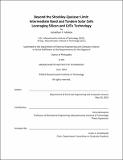| dc.contributor.advisor | Tonio Buonassisi. | en_US |
| dc.contributor.author | Mailoa, Jonathan P | en_US |
| dc.contributor.other | Massachusetts Institute of Technology. Department of Electrical Engineering and Computer Science. | en_US |
| dc.date.accessioned | 2016-12-22T15:16:07Z | |
| dc.date.available | 2016-12-22T15:16:07Z | |
| dc.date.copyright | 2016 | en_US |
| dc.date.issued | 2016 | en_US |
| dc.identifier.uri | http://hdl.handle.net/1721.1/105950 | |
| dc.description | Thesis: Ph. D., Massachusetts Institute of Technology, Department of Electrical Engineering and Computer Science, 2016. | en_US |
| dc.description | This electronic version was submitted by the student author. The certified thesis is available in the Institute Archives and Special Collections. | en_US |
| dc.description | Cataloged from student-submitted PDF version of thesis. Page 156 blank. | en_US |
| dc.description | Includes bibliographical references (pages 141-153). | en_US |
| dc.description.abstract | The efficiencies of single-junction solar cells have been rapidly increasing and approaching their fundamental Shockley-Queisser efficiency limits. This is true for mature commercial technologies such as silicon and cadmium telluride. In order to enable solar cells with higher efficiency limits, new concepts need to be implemented which overcome the fundamental energy conversion mechanism limitations of single-junction solar cells. For this approach to be successful, it is advantageous to leverage existing manufacturing facilities and integrate these new solar cell architectures into commercially successful solar cell technologies such as silicon and cadmium telluride. In this thesis, two novel solar cell concepts are explored, categorized into three contributions. First, the application of intermediate band concept on silicon solar cells is explored by hyperdoping silicon, demonstrating room-temperature sub-band gap optoelectronic response from the material, and evaluating the feasibility of the intermediate band approach for improving silicon solar cell efficiency. Second, perovskite solar cells are integrated onto silicon solar cells to demonstrate mechanically-stacked perovskite/silicon tandem solar cell using low-cost silicon cell and monolithic perovskite/silicon tandem solar cell enabled by a silicon tunnel junction. Third, an analytic model is built to rapidly investigate the energy yield of different tandem solar cell architectures. When applied to cadmium telluride-based tandem solar cells, this model will help thin-film companies like First Solar narrow down the scope of future research and development programs on tandem solar cells. | en_US |
| dc.description.statementofresponsibility | by Jonathan P. Mailoa. | en_US |
| dc.format.extent | xx, 156 pages | en_US |
| dc.language.iso | eng | en_US |
| dc.publisher | Massachusetts Institute of Technology | en_US |
| dc.rights | M.I.T. theses are protected by copyright. They may be viewed from this source for any purpose, but reproduction or distribution in any format is prohibited without written permission. See provided URL for inquiries about permission. | en_US |
| dc.rights.uri | http://dspace.mit.edu/handle/1721.1/7582 | en_US |
| dc.subject | Electrical Engineering and Computer Science. | en_US |
| dc.title | Beyond the Shockley-Queisser limit : intermediate band and tandem solar cells leveraging silicon and CdTe technology | en_US |
| dc.type | Thesis | en_US |
| dc.description.degree | Ph. D. | en_US |
| dc.contributor.department | Massachusetts Institute of Technology. Department of Electrical Engineering and Computer Science | |
| dc.identifier.oclc | 965379895 | en_US |
